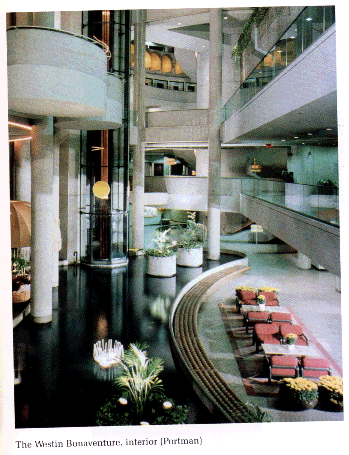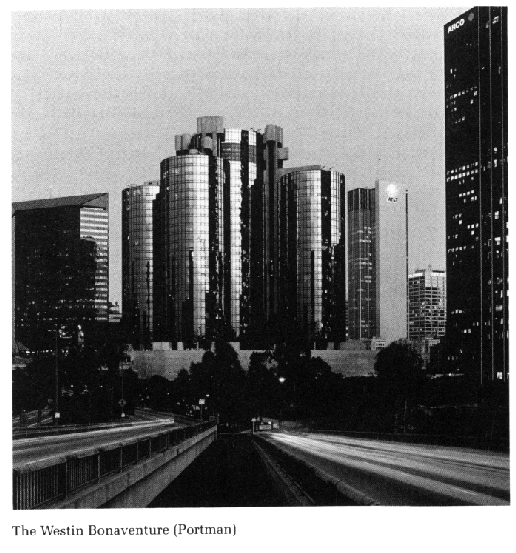interior

There are three entrances
to the Bonaventure, one from Figueroa and the other two by way of elevated
gardens on the other side of the hotel, which is built into the remaining
slope of the former Bunker Hill. None of these is anything like the old
hotel marquee, or the monumental porte cochere with which the sumptuous
buildings of yesteryear were wont to stage your passage from city street
to the interior. The entryways of the Bonaventure are, as it were, lateral
and rather backdoor affairs: the gardens in the back admit you to the sixth
floor of the towers, and even there you must walk down one flight to find
the elevator by which you gain access to the lobby. |
Meanwhile, what one
is still tempted to think of as the front entry, on Figueroa, admits you,
baggage and all, onto the second story shopping balcony, from which you
must take an escalator down to the main registration desk. What I first
want to suggest about these curiously unmarked ways in is that they seem
to have been imposed by some new category of closure governing the inner
space of the hotel itself (and this over and above the material constraints
under which Portman had to work). I believe that, with a certain number
of other characteristic postmodern buildings, such as the Beaubourg in
Paris or the Eaton Centre in Toronto, the Bonaventure aspires to being
a total space, a complete world, a kind of miniature city; to this new
total space, meanwhile, corresponds a new collective practice, a new mode
in which individuals move and congregate, something like the practice of
a new and historically original kind of hypercrowd. In this sense, then,
ideally the minicity of Portmaní Bonaventure ought not to have entrances
at all, since the entryway is always the seam that links the building to
the rest of the city that surrounds it: for it does not wish to be a part
of the city but rather its equivalent and replacement or substitute. That
is obviously not possible, whence the downplaying of the entrance to its
bare minimum. But this disjunction from the surrounding city is different
from that of the monuments of the International Style, in which
the act of disjunction was violent, visible, and had a very real symbolic
significance--as in Le Corbusierís great pilotis, whose gesture
radically separates the new Utopian space of the modern from the degraded
and fallen city fabric which it thereby explicitly repudiates (although
the gamble of the modern was that this new Utopian space, in the virulence
of its novum, would fan out and eventually transform its surroundings by
the very power of its new spatial language). The Bonaventure, however,
is content to "let the fallen city fabric continue to be in its being"
(to parody Heidegger); no further effects, no larger protopolitical Utopian
transformation, is either expected or desired. |

